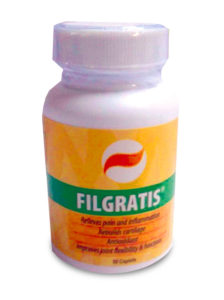
FILGRATIS®
COMPOSITION:
| Each film coated caplet contains: | |
| Glucosamine Sulfate Potassium Chloride USP | 750 mg |
| Methyl Sulfonyl methane USP | 250 mg |
| Grape Seed Extract USP | 25 mg |
| Boswellia Extract USP | 75 mg |
| Turmeric Extract USP | 12.5 mg |
| Boron Amino Acid Chelate | 20 mg |
| Vitamin A USP | 250 IU |
| Chondroitin Sulfate Sodium BP | 50 mg |
| Excipients: | Q.S. |
INTRODUCTION
FILGRATIS® caplets deliver the triple-healing action of Glucosamine, Chondroitin and MSM to damaged joints; reliving pain and stiffness while promoting greater flexibility and ease of motion. It is further enhanced by the inclusion of Grape Seed extract a natural antioxidant, and two highly beneficial anti-inflammatory herbs, Boswellia Extract and Turmeric, combine to maintain cell health and reduce inflammation. Plus the powerful anti-oxidant protection of Vitamin A and Boron to help prevent cell damage from free radical activity.
FILGRATIS® Caplets helps in building and maintaining cartilage, joint casings, tendons and other connective tissues. It also contributes to the maintenance of joint fluid, thus supporting joint lubrication. FILGRATIS caplets have been used for pain and swelling of the joints caused by osteoarthritis and other diseases of the joint when the cartilage is damaged. It helps to rebuild cartilage in knees, hips and other joints of the body. It improves joint mobility and function.
INDICATIONS
FILGRATIS® is used in management of the following:
- Osteoarthritis
- Rheumatoid Arthritis (as adjunct)
- In any other conditions of joint discomfort or cartilage damage
DOSAGE:
1 caplet twice daily with a meal.
MECHANISM OF ACTION
Glucosamine sulfate potassium chloride
Exogenous administration of glucosamine increases the synthesis of proteoglycans in articular cartilage and inhibits the breakdown of cartilage. Long-term studies indicate that glucosamine can inhibit the breakdown of articular cartilage, probably by inhibition of catabolic enzymes. In articular cartilage, chondrocytes utilise glucosamine in the synthesis of glycosaminoglycans.
Methyl Sulfonyl methane (MSM)
MSM is found in every cell and is important to structural and internal health.
MSM is an essential part of amino acid chains. It is the flexible bond between proteins, hence its ability to restore flexibility into cells and tissues.
Grape seed
Grape seed extracts have compounds called procyanidolic oligomers (PCOs). PCOs are powerful antioxidants, 20 times more potent than vitamins C, beta-carotene and 50 times more potent than vitamin E. They also inhibit a number of enzymes that degrade connective tissue such as elastase, collagenase, and hyaluronidase.
Boswellia
Some studies show that boswellic acid can prevent the formation of leukotrienes in the body. Leukotrienes have been identified as a cause of inflammation and may trigger asthma symptoms. Four acids in boswellia resin contribute to its anti-inflammatory properties. These acids inhibit 5-lipoxygenase (5-LO), an enzyme that produces leukotriene. Acetyl-11-keto-β-boswellic acid (AKBA) is thought to be the most powerful of the four boswellic acids.
Boswellia also decreases the degradation of glycosaminoglycans thereby helping to prevent the destruction of articular cartilage
Turmeric
Turmeric contains curcuminoids (polyphenols) which have anti-inflammatory (COX inhibition) properties; it stimulates production & release of bile in addition to antispasmodic; hepatoprotective; antioxidant properties.
Boron amino acid
Boron supports mineral metabolism and cell membrane function/structure. Boron influences the strength and structure of the bones.
Boron is a mineral with great importance because of;
- The ability to retain and add bone tissue.
- Boron has been found to be quintessential to healthy bone structure, its presence being necessary for bone to be protected against calcium leeching.
- Potentiates the regeneration of primal bone material.
- Prevents osteoporosis (a disease of bone degeneration)
Vitamin A
Beta-carotene(Vitamin A) is an antioxidant. Free radicals contribute to degenerative processes seen in aging. e.g. Osteoarthritis.
Bone remodeling, normal functioning of osteoblasts and osteoclasts is dependent upon vitamin A.
Chondroitin sulfate
The effect of chondroitin sulfate in patients with osteoarthritis is likely the result of a number of reactions including its anti-inflammatory activity, the stimulation of the synthesis of proteoglycans and hyaluronic acid, and the decrease in catabolic activity of chondrocytes inhibiting the synthesis of proteolytic enzymes, nitric oxide, and other substances that contribute to damage cartilage matrix and cause death of articular chondrocytes. A recent review summarizes data from relevant reports describing the biochemical basis of the effect of chondroitin sulfate on osteoarthritis articular tissues. The rationale behind the use of chondroitin sulfate is based on the fact that osteoarthritis is associated with a local deficiency or degradation of natural substances, including internal chondroitin sulfate. Chondroitin sulfate is an important structural component of cartilage and provides much of its resistance to compression.
CONTRAINDICATIONS
FILGRATIS® is contraindicated in pregnancy and breast feeding mothers, allergy to shellfish, grape allergies and gall stones.
PRESENTATION
FILGRATIS® is presented as a bottle containing 30 caplets.
